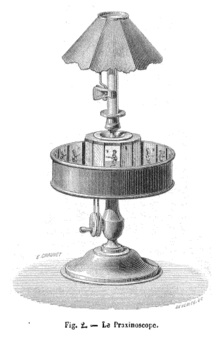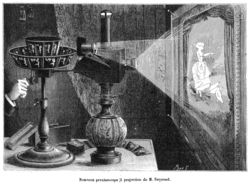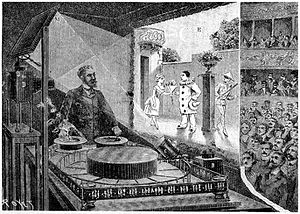
Back Praxinoscopiu AST Praksinoskop Breton Praxinoscopi Catalan Praxinoskop German Praksinoskopo Esperanto Praxinoscopio Spanish Praksinoskooppi Finnish Praxinoscope French פרקסינוסקופ HE Prassinoscopio Italian
This article needs additional citations for verification. (March 2011) |



The praxinoscope was an animation device, the successor to the zoetrope. It was invented in France in 1877 by Charles-Émile Reynaud. Like the zoetrope, it used a strip of pictures placed around the inner surface of a spinning cylinder. The praxinoscope improved on the zoetrope by replacing its narrow viewing slits with an inner circle of mirrors,[1] placed so that the reflections of the pictures appeared more or less stationary in position as the wheel turned. Someone looking in the mirrors would therefore see a rapid succession of images producing the illusion of motion, with a brighter and less distorted picture than the zoetrope offered.
- ^ Brunn, edited by Stanley D.; Cutter, Susan L.; Harrington, J.W. Jr. (31 March 2004). Geography and technology. Dordrecht: Kluwer Academic Publishers. p. 274. ISBN 978-1402018718.
{{cite book}}:|first1=has generic name (help)
© MMXXIII Rich X Search. We shall prevail. All rights reserved. Rich X Search